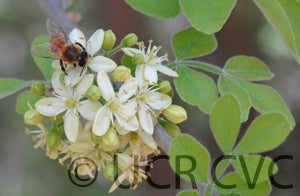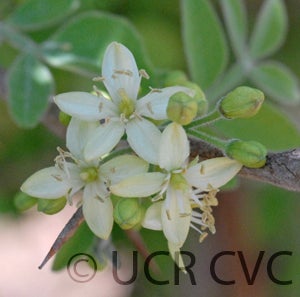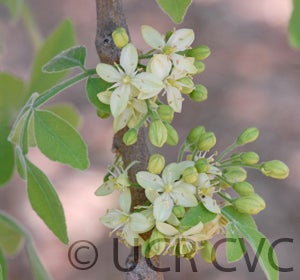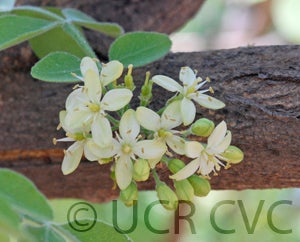Mozambique cherry-orange
CRC 3294
PI 247137
Source
Received as seed from Dr. G.R. Bates, Causeway, Salisbury, Rhodesia, 1958.
Parentage/origins
Parents unknown.
Rootstocks of accession
Carrizo citrange, C-35 citrange
Season of ripeness at Riverside
November to December
Season of flowering at Riverside
June to July
Notes and observations
11/1958, EMN: Of 15 seeds: 10 germ. & were all singles.
8/1961, EMN: Meiwa on Daweana made good growth, good color.
2/1987, EMN: Both trees in field 18B have now died. Probably this accession is too tender for the field here & we should keep it in the GH & LH only.
5/1987, EMN: Two more field trees planted for trial- if these die, keep in GH & LH only, for sure.
12/22/1987, EMN: Tree at 18B had almost died and was removed from record. Has somewhat recovered now but has much dieback. Apparently this accession is not well adapted to Riverside.
11/1989, EMN: No fruit.
Description from The Citrus Industry Vol. 1 (1967)
"A shrub or small tree, 3 -5 m high, branchlets at first angular, soon cylindrical, 2 -4 mm diam; internodes 2-3 cm long; spines axillary, solitary, short, straight, 1-2.5 cm long, 2-4 mm diam. at base, shorter ones blunt-pointed, the longer ones (1.5-2.5 cm) sharp-pointed; leaves 5-7-foliolate; leaflets elliptical to rhomboid or ovate, bluntly rounded at the apex, terminal one narrowly cuneate at base, 5-5.8 X 2-2.4 cm, lateral ones broadly cuneate or broadly rounded at base, 2-4.5 X 1.5-2.4, with 4-6 rather inconspicuous veins, sparsely and evenly dotted with small translucent oil glands, sparingly pubescent on both sides and on the margins with very slender, colorless ciliate hairs, margins finely and shallowly crenate or subentire, petiolules very short (1-1.8 mm); petioles nearly or quite wingless. 1.2-2.2 cm long, 1-1.5 mm wide; first rachis segments 1.5-2 cm long, with spathulate wings, 3-6 mm wide and rounded at the distal end, usually narrowed to a subacuminate base at the proximal end, second rachis segments elliptical, broader (about 2.5 X 0.8 cm), not spathulate; flowers and fruits unknown.
This remarkable species is known only from the type material collected by M. T. Dawe (when director of agriculture of the Companhia de Moçambique) in the Madanda Forest, a rubber-producing region, which lies 100 to 200 kilometers to the southwest of Beira, between the Lucite River (Lat. 20° S.) and the Save River (Lat. 21° 30' S.), to the west of the Sofala lands (about Long. 34° E.) and to the east of the Mossurize district (about Long. 33° E.).
Unfortunately, the flowers and fruits of this species are unknown; however, the leaf characters are so distinctive that it cannot be mistaken for any other Citropsis. The leaves, including the petioles and rachis segments, are sparingly pubescent on both surfaces, whereas in all the other species they are glabrous; the leaflets are the smallest known in the genus. The petiole-rachis wings become progressively wider toward the tip of the leaf, that is, the petiole is wingless or nearly so, the first rachis segment narrowly winged (wider at the tip), and the second segment still wider. This is just the reverse of what is found in the other winged species of Citropsis. The scanty type material seems to show Kurztrieben, like the leaf and flower spurs of Poncirus trifoliata and some of the Hard-Shelled Citroid Fruit Trees (subtribe Balsamocitrinae).
The leaf, petiole, and rachis characters of this species show a great similarity to those of certain forms of Hesperethusa crenulata from peninsular India. However, as noted above, certain forms of Citropsis gabunensis have leaves and petioles greatly resembling those of Citrus but have flowers and fruits unmistakably belonging to Citropsis. Only the study of flowers and fruits can reveal the exact relationships of C. daweana.
The Mozambique cherry-orange has the appearance of being a somewhat xerophytic plant; the other species are evidently mesophytes and usually grow in tropical rain forests.
This is without question the least known species of the genus Citropsis and at the same time the most distinct one! When flowers and fruits are available for study it will very probably be found to constitute a new subgenus, if not a new genus. It is of great phylogenetic interest as a measure of the nature and rate of evolution that has occurred since Citropsis was cut off from any connection with its relatives in southeastern Asia, eastern India, and the Monsoon region."
Availability
Not commercially available in California.
USDA Germplasm Resources Information Network page for Citropsis daweana









